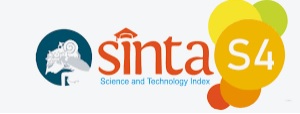Analisis Jumlah Pelanggan dan Tingkat Produksi Listrik di Kota Salatiga Menggunakan Triple Exponential Smoothing
Abstract
Indonesia, amidst rapid economic growth, confronts challenges in meeting the escalating demand for electrical energy. Salatiga, located in Central Java and part of this dynamic landscape, experiences significant pressure on its electrical infrastructure due to substantial economic and population growth. The Triple Exponential Smoothing (TES) methodology is adopted in this study to estimate future customer numbers and power production levels. The research results indicate that the MAPE (Mean Absolute Percentage Error) for the number of electricity customers is 4.64% < 10%, indicating that the forecasting is very accurate. For the electricity production level, the MAPE is 16.63%, which is considered good for forecasting. These outcomes can be utilized as a framework for making decisions regarding electricity in the city of Salatiga.
Kata kunci: Electricity Customers; Electricity Production Levels; Forecasting; Triple Exponential Smoothing
Abstrak
Indonesia, dengan pertumbuhan ekonomi yang pesat, menghadapi tantangan pemenuhan kebutuhan energi listrik yang terus meningkat. Kota Salatiga, Jawa Tengah, sebagai bagian dari dinamika ini, mengalami tekanan besar pada infrastruktur energi listrik akibat pertumbuhan ekonomi dan populasi yang signifikan. Penerapan metode Triple Exponential Smoothing (TES) untuk menganalisis dan memprediksi jumlah pelanggan serta tingkat produksi listrik di masa depan. Temuan penelitian menyatakan didapatkan bahwa MAPE (Mean Absolute Percentage Error) untuk jumlah pelanggan listrik adalah 4,64% < 10% dimana hasilnya adalah permalan sudah sangat akurat dan untuk tingkat produksi listrik adalah 16,63% dimana hasil ini adalah baik untuk peramalan sehingga hal ini dapat menjadi panduan bagi pengambilan keputusan terkait energi listrik di Kota Salatiga.
Â
Keywords
References
I. N. Darmawan and Kholistianingsih, “Perencanaan dan Pemenuhan Energi Listrik di Kota Salatiga,†Jurnal Teodolita, vol. 22, no. 2, pp.102 - 110, 2021.
R.N Puspita, “Peramalan Tingkat Pengangguran Terbuka Provinsi Banten Dengan Metode Triple Exponential Smoothing,†Jurnal Lebesgue, vol. 3, no. 2, pp. 358 - 366, 2022.
L. I. Effendie, U. P. Wysnawati and Q. Ainunnisa, “Perbandingan Analisis Peramalan Double Exponential Smoothing dan Triple Exponential Smoothing Pada Indeks Harga Konsumen di Yogyakarta Tahun 2012 - 2022,†Jurnal Bayesian, vol. 3, no. 1, pp. 122 - 131, 2023.
J. Vimala and A. Nugroho, “Forecasting Penjualan Obat Menggunakan Metode Single, Double, Dan Triple Exponential Smoothing ( Studi Kasus : Apotek Mandiri Medika),†Jurnal Penerapan Teknologi Informasi dan Komunikasi, vol. 1, no 2, pp. 90 - 99, 2022.
Z. Liu , Z. Zhu, J. Gao, and C. Xu, “Forecast Methods for Time Series Data: A Survey,†IEEE Access, vol. 9, pp. 91896 - 91912, 2021.
M. Arumsari and A. T. R. Dani, “Peramalan Data Runtun Waktu menggunakan Model Hybrid Time Series Regression – Autoregressive Integrated Moving Average,†Jurnal Siger Matematika, vol. 2, no. 1, pp. 1 - 12, 2021.
H. Hassyddiqy and Hasdiana, “Analisis Peramalan (Forecasting) Penjualan Dengan Metode ARIMA (Autoregressive Integrated Moving Average) Pada Huebee Indonesia,†Jurnal Data Science Indonesia, vol. 2, no. 2, pp. 92 - 100, 2021.
M. Olivia and Amelia, “Metode Exponential Smoothing Untuk Forecasting Jumlah Penduduk Miskin Di Kota Langsa,†Jurnal Gamma-Pi, vol. 3, no. 1, pp. 47 - 52, 2021.
D. Santika, R. S. Hayati and I. Lazuli, “Penerapan Metode Triple Exponential Smoothing Dalam Prediksi Penanaman Bibit Kelapa Sawit Pada PT. Palmanco Inti Sawit,†Jurnal InfoSys, vol. 5, no. 1, pp. 12 - 24, 2020.
N. P. L. Santiariand and I. G. S. Rahayuda, “Penerapan Metode Exponential Smoothing Untuk Peramalan Penjualan Pada Toko Gitar,†JOINTECS, vol. 5, no. 3, pp. 203, 2020, doi: 10.31328/jointecs.v5i3.1520.
R. B. Saputro, K. P. Kartika, and W. D. Puspitasari, “Implementation of the Triple Exponential Smoothing Method for Predicting Helmet Sales,†Network, Comput. Sci, vol. 4, no. 2, pp. 30–34, 2022.
M. Abdy, Irwan and F. Lukman, “Penggunaan Metode Double Exponential Smoothing dalam Meramalkan Indeks Harga Konsumen (IHK) di Kota Makassar,†JOMTA, vol. 5, no. 2, pp. 61 -66, 2023.
D. M. Khairina, Y. Daniel and P. P. Widagdo, “Comparison of double exponential smoothing and triple exponential smoothing methods in predicting income of local water company,†Journal of Physics: Conference Series, vol. 1943, pp. 1 - 10, 2021, doi: doi:10.1088/1742-6596/1943/1/012102
Bustami, A. M. Yolanda and N. Thahira, “Forecasting Non-Oil and Gas Exports in Indonesia Using Double and Triple Exponential Smoothing Methods,†International Journal of Industrial Engineering and Engineering Management (IJIEEM), vol. 5, no. 1, pp. 45 - 49, 2023.
G. Agiyani, Malahayati and A. S. Wati, “Perbandingan Menggunakan Metode Exponential Smoothing Untuk Prediksi Jumlah Polis Asuransi Kendaraan Pada PT X Kota Palembang,†Journal of Information Technology Ampera, vol. 3, no. 3, pp. 382 -390, 2022.
How To Cite This :
Refbacks
- There are currently no refbacks.











